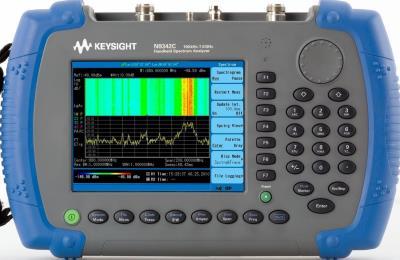
|
|
The Keysight N9342C 7 GHz handheld spectrum analyzer (HSA) puts the speed and performance of spectrum analysis in the hands of your field engineers. It provides powerful features for field applications. Plus, the HSA’s superior performance gives you confidence in field test results while the optimized user interface enhances field productivity. A superior combination of low displayed average noise level (DANL) and single sideband (SSB) phase noise coupled with a narrow resolution bandwidth (RBW) means your signal measurements are more reliable and you will have more confidence in your test results.
Specifications.
Frequency.
Range: 100 kHz to 7 GHz (usable to 9 kHz, Option BB1).
Frequency span.
Range: 0 Hz (zero span), 100 Hz to 7 GHz.
Resolution: 1 Hz.
Accuracy: ± (0.22% ×span + span/(sweep point −1)), nominal.
Sweep time.
Range: 2 ms to 1000 s (Span ≥ 100 Hz), 600 ns to 200 s (Span = 0 Hz(zero span)).
Mode: Continuous, Single.
Trigger Source: Free run, video, external, RF burst.
Resolution bandwidth (RBW).
Range (−3 dB bandwidth): 10 Hz to 3 MHz in 1-3-10 sequence.
Accuracy: ± 5%, RBW = 10 Hz to 1 MHz (Nominal), ± 10%, RBW = 3 MHz.
Measurement range.
100 kHz to 2 MHz: Displayed average noise level (DANL) to +10 dBm, Preamp off.
2 MHz to 7 GHz: Displayed average noise level (DANL) to +20 dBm, Preamp off.
Input attenuator range: 0 to 50 dB, in 1 dB steps.
Maximum safe input level.
Average continuous power: +33 dBm, 3 minutes maximum.
DC voltage: ± 50 VDC maximum.
Displayed average noise level (DANL) Preamp on, Normalized to 1 Hz.
100 kHz to 1 MHz: −131 dBm, −150 dBm typical.
1 to 10 MHz: −148 dBm, −163 dBm typical.
10 to 500 MHz: −161 dBm, −164 dBm typical.
500 to 2.5 GHz: −159 dBm, −162 dBm typical.
2.5 to 4 GHz: −158 dBm, −161 dBm typical.
4 to 6 GHz: −155 dBm, −158 dBm typical.
6 to 7 GHz: −150 dBm, −154 dBm typical.
Options.
N9342C-AMA, AM/FM Modulation Analysis.
N9342C-BB1, Baseband Input.
N9342C-CA7, Handheld Cable and Antenna Tester, 5 MHz to 7 GHz.
N9342C-DMA, ASK/FSK Modulation Analysis.
N9342C-EMC, EMI filters and quasi-peak detector.
N9342C-GPS, Built-in GPS Receiver with Built-in GPS Antenna.
N9342C-PA7, Preamplifier, 7.0 GHz.
N9342C-PWM, USB Average Power Sensor Support (U2000 Series).
N9342C-PWP, USB Peak and Average Power Sensor Support (U2020/U2040 X-Series).
N9342C-SCN, Channel Scanner.
N9342C-SEC, Security Features.
N9342C-SIM, Spectrum Monitor with Spectrogram Record and Playback.
N9342C-TG7, Tracking Generator, 7 GHz.
N9342C-TMG, Time-Gated Spectrum Analysis.
N9342C-TPN, Task Planner for Test Automation.
|